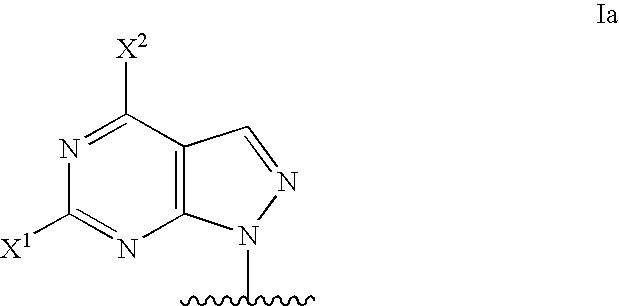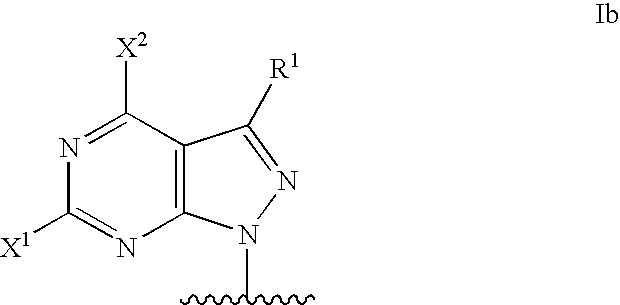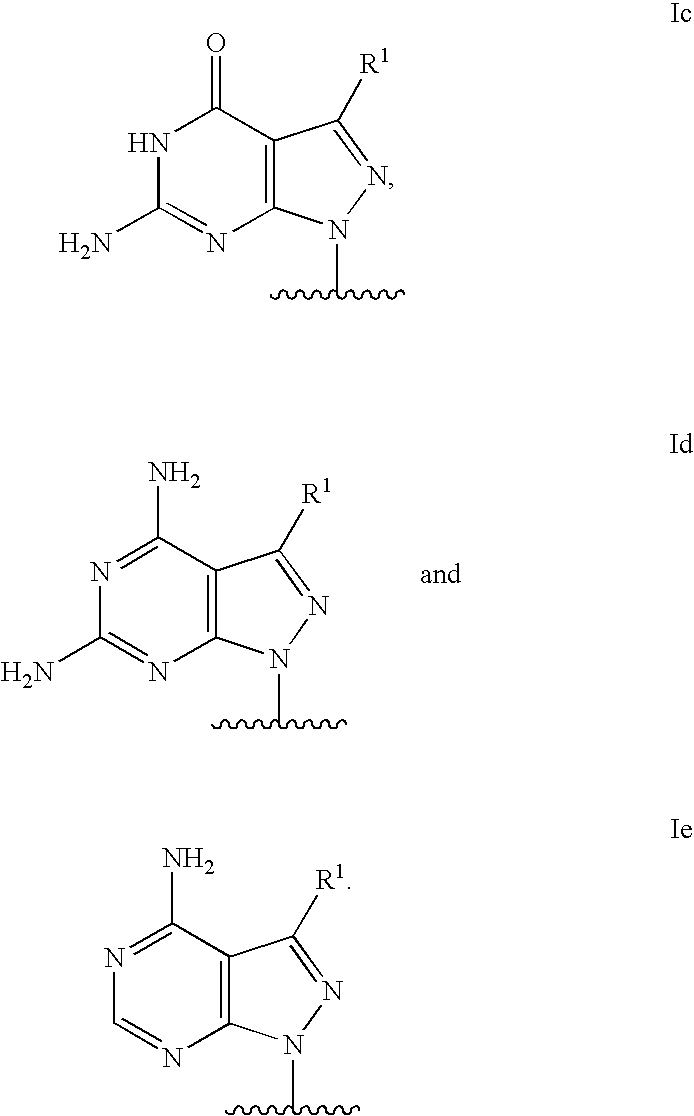Modified oligonucleotides for mismatch discrimination
a technology of modified oligonucleotides and mismatching, applied in the field of molecular biology, can solve the problem that the potential discriminatory power of short oligonucleotides cannot be easily realized
- Summary
- Abstract
- Description
- Claims
- Application Information
AI Technical Summary
Benefits of technology
Problems solved by technology
Method used
Image
Examples
example 1
[0264]This example illustrates the synthesis of 5-(Prop-2-ynyl-4-methylbenzoate)-5′-O-(4,4′-dimethoxytriphenylmethyl)-2′-deoxyuridine 3′-[(2-cyanoethyl) N,N-diisopropylphosphoramidite] (3).
5-(Prop-2-ynyl-4-methylbenzoate)-2′-deoxyuridine (1).
[0265]To a mixture of 5-iodo-2′-deoxyuridine (5.0 g, 14.12 mmol), CuI (270 mg, 1.42 mmol), Pd(PPh3)4 (0.82 g, 0.714 mmol), and triethylamine (2.4 mL) in 30 mL of anhydrous DMF was added prop-2-ynyl 4-methylbenzoate (6.10 g, 35.06 mmol). The mixture was stirred under argon for 4 h. and then evaporated to dryness. The residue was triturated in methanol and the excess prop-2-ynyl 4-methylbenzoate that precipitated was filtered away. The filtrate was evaporated and the residue was purified by silica gel chromatography eluting with 10% methanol in ethyl acetate. The pure product fractions were evaporated to dryness and the residue was precipitated from ethyl aceate-ether: 3.14 g (56%) yield; TLC (10% methanol in ethyl acetate), Rf=0.50; 1H NMR (DMSO-...
example 2
Phase 1 Preparation of (2R,5R)-5-(4-amino-3-iodopyrazolo[3,4-d]pyrimidinyl)-2-(hydroxymethyl)oxolan-3-ol (9)
3-Iodo-1,5-dihydropyrazolo[3,4-d]pyrimidin-4-one (4).
[0268]The synthesis of this compound was previously reported by Taylor et. al (Tetrahedron, 48(37):8089–8100 (1992)) using a N-iodosuccinimide. Our synthesis, employing iodine momochloride as the iodinating agent is described below.
[0269]To a 1.0 L solution of 1.2 M sodium acetate was added 4-hydroxypyrazolo[3,4-d]pyrimidine (25 g, 184 mmol) followed by iodine monochloride (46 g, 284 mmol). The mixture was stirred in a sealed container for 4 h. at 110° C. The completed reaction was cooled to room temperature and treated with a solution of 30 g of sodium metabisulfite in 200 mL of water. The white precipitate that formed was filtered and rinsed with cold water. The solid was then dissolved in 200 mL of 3.2 M potassium hydroxide solution. Hydrazine monohydrate (5 mL) was added and the solution was stirred for 15 min. The solut...
example 3
[0279]This example illustrates the preparation of N-{3-[1-((2R,5R)-5 {[bis(4-methoxyphenyl)phenylmethoxy]methyl}-4-{[bis(methylethyl)amino](2-cyanoethoxy)phosphinooxy}oxolan-2-yl)-6-amino-4-oxo(5-hydropyrazolo[3,4-d]pyrimidin-3-yl)]propyl}-2,2,2-trifluoroacetamide (22).
3-Iodo-4-methoxypyrazolo[3,4-d]pyrimidine-6-ylamine(14).
[0280]4-Methoxy-pyrazolo[3,4-d]pyrimidin-6-ylamine (6.75 g, 40.87 mmol) was suspended in an aqueous solution containing sodium acetate (6.0 g, 44.09 mmol) and iodine monochloride (9.12 g, 56.17 mmol) and stirred at 100° C. in a sealed reaction vessel for 24 h. The resulting mixture was cooled to room temperature and treated with a solution of sodium metabisulfite (3.6 g, 18.94 mmol) in 24 mL of water. The solid that formed was filtered, rinsed with water and dried: 6.93 g (58%) yield; TLC (10% methanol in ethyl acetate), Rf=0.57; 1H NMR (DMSO-d6) δ 13.08 (1H, br s, N-1 proton), 10.58 (1H, s, N—S proton), 6.60 (2H, br s, 6-amino).
[(2R,5R)-5-(6-Amino-3-Iodo-4-metho...
PUM
 Login to View More
Login to View More Abstract
Description
Claims
Application Information
 Login to View More
Login to View More - R&D
- Intellectual Property
- Life Sciences
- Materials
- Tech Scout
- Unparalleled Data Quality
- Higher Quality Content
- 60% Fewer Hallucinations
Browse by: Latest US Patents, China's latest patents, Technical Efficacy Thesaurus, Application Domain, Technology Topic, Popular Technical Reports.
© 2025 PatSnap. All rights reserved.Legal|Privacy policy|Modern Slavery Act Transparency Statement|Sitemap|About US| Contact US: help@patsnap.com



